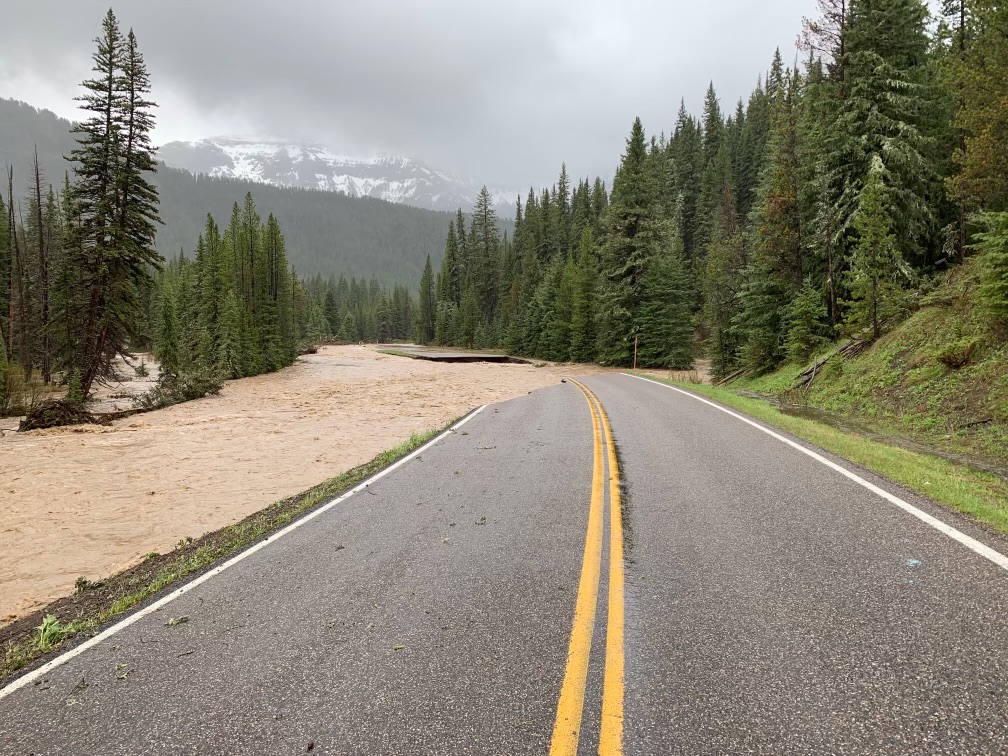

Until early this week, Yellowstone National Park was gearing up for a high-traffic summer season. Park staff and local tourism were anticipating many visitors coming to celebrate the 150th anniversary of the country’s first national park and the renaming of 10,551-foot-peak Mount Doane to First Peoples Mountain, in honor of America’s Indigenous people. But the festive energy came to a halt on Monday morning: a historic flood swept through the park, destroying bridges and roads in the northern section.
All park entrances closed and more than 10,000 visitors were ordered to leave. River gauges reached record highs as the water swelled. Throughout the region, towns have been damaged, hit with power outages and water shortages, or cut off by the floodwaters completely. On Wednesday, Montana’s lieutenant governor requested a presidential major disaster declaration.
The region has seen floods before, but not of this magnitude, says Sierra Harris, climate change coordinator at the conservation-focused nonprofit Greater Yellowstone Coalition. Under a warming climate, trends suggest that these kinds of events will become more common—which will have major implications for future park infrastructure and local communities.
[Related: Yellowstone floods could be flushing sewage into the park’s iconic river]
Rainfall and snowmelt were the main factors contributing to the flood’s severity, creating what experts call a ‘rain-on-snow’ event. But the conditions that made the flood as strong as it was had been building up for weeks, says Harris. The storm that hit Beartooth Mountain, northeast of the park, was the catalyst. Up to five inches of rain fell in some parts, which is an unusually high amount.
“That kind of intensity can be like several months of precipitation in one event,” says Steve Hostetler, a hydrologist for the US Geological Survey and co-author of the June 2021 Greater Yellowstone Climate Assessment. But this rainfall accumulated in just a few days between June 10 to June 13. The intense, warmer rains melted much of the snowpack, which had been higher than average for this time of year. This contributed to the unprecedented runoff levels.
Rain-on-snow floods are expected to increase as climate change drives temperatures upwards in the area. Cathy Whitlock, earth science professor at Montana State University and another coauthor of the Greater Yellowstone Climate Assessment, points to two reasons in particular. First, snowmelt will occur earlier and melt faster, which will lead to more spring flooding. Second, rain-on-snow events will happen at higher altitudes, as elevations that are now dominated by snow will instead experience more rain.
Harris says this flood is waking some people up to the increasingly intense climate variability in the area. For her, it’s ironic that the flood is drawing national awareness and conversations around climate change when drought is one of the main issues impacting the Greater Yellowstone area. While floods typically indicate an excess of water, in this case, they can herald potential issues for drought, too, Harris suggests. Good precipitation created promising snowpack levels in the mountains this spring. It would have been beneficial for this snowmelt reserve to slowly feed dry land throughout the summer, says Harris, but explains that instead, the water reserve came down as a massive flooding release all at once.
“I think this [flood] is indicative of dramatic changes on their way,” Harris says. She’s currently working on ways to store water runoff to use later in the summer. “We have a chance to mitigate and the time is now to make changes.”
[Related: When rain is just as dangerous as drought]
In 2021, the National Park System (NPS) developed a management resource to help parks deal with the impacts of climate change. The plan was released just ahead of last year’s federal infrastructure bill, which has allotted $1.7 billion for NPS, including funds for climate mitigation projects. This will supplement the Great American Outdoors Act of 2020, which is designed to provide up to $1.9 billion per year for five years to make enhancements to the parks that have been put off due to lack of funding. The NPS currently faces a $22 billion backlog of deferred maintenance. Earlier this year, Yellowstone National Park reported that they had an estimated $929 million in deferred maintenance and repairs.
“The infrastructure [of Yellowstone National Park] wasn’t built to take this magnitude of a flood. But if you knew it was going to happen, would you have gone in and rebuilt everything to withstand it?” Hostetler says. “It’s the analysis of cost and potential threat.”
Local communities are still reeling from the flood damages and costs to recover livelihoods, but people in the area who depend on tourism anticipate particularly difficult times ahead. Many are still dealing with the impacts of the COVID pandemic, and the flood is another setback.
“Everybody is bouncing back from not having tourists from COVID, and now this,” says Harris, who is from Montana. “And Yellowstone isn’t the only attraction, everything and everyone has been impacted.”
The park remains closed until infrastructure is further assessed for damage, but officials hope to repair the southern entrances. It’s unlikely, they said, that the northern entrances will reopen this season.
